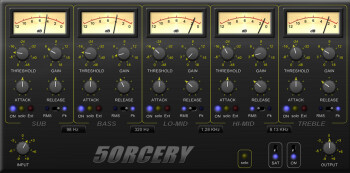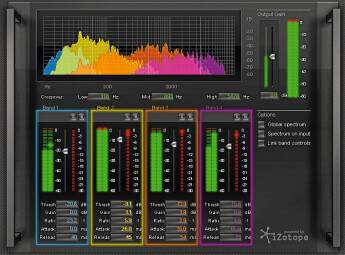In the previous article, we addressed compression within the context of home mastering with a classic compressor. It's time now to tackle multi-band compression.
What’s that you said?
As its name implies, a multi-band compressor is, first and foremost, a compressor. In this capacity, it has more or less the same parameters as a classic compressor, but it is capable of applying a different compression to each band into which the frequency range is divided. Thus, you can choose different ratio, threshold and makeup gain, as well as attack and release times, for each frequency band.
What is it for?
Low frequencies give a mix its energy. Consequently, a compressor has a tendency to react more frequently to peaks in this zone of the frequency range. So, if the song you are working on has some pretty “wild” dynamics in the low end, it is possible that the compressor literally squashes whatever is happening throughout the rest of the spectrum at that same time. On the other hand, considering that the wavelengths become shorter as the frequency increases, it can be wise to use significantly different time constants depending on the frequency band, in order to achieve a more respectful compression of the peaks while keeping everything tight.
In short, a multi-band compressor will allow you to go further when dealing with the dynamics of a song while staying transparent. But you need some know-how in order to achieve that, because this type of processing can spoil a mix. Bear in mind that you are not only affecting the dynamics, but also the spectral balance. You can end up messing up your work really bad if you are not careful. So, if a traditional compressor can do the work, stick with that rather than embarking on something that may be beyond your capabilities.
Methodology
The first thing you should do is define how you will split the frequency bands. Remember that less is more, which means it’s better to work with as few bands as possible. Two bands might be enough and three is the average. If you need more bands it usually hints at a problem at the mix level, so you’d better go back to the source, if possible. In order to fix the limits for each band, follow these steps:
- To separate the lows and mids, try to find the fullness of the bass guitar and the kick drum, without encroaching on the foundations of the vocals, guitars, piano, etc. A good starting point is somewhere around 120 Hz;
- When it comes to the limit between mids and highs, try to keep the whole vocal range in the mid band, or you risk distorting it completely with the compression. You should find your goal somewhere between 5 kHz and 8 kHz.
Once you’re done with this splitting, the procedure to adjust the compression of each band doesn’t differ from what we’ve seen in the previous article. Multi-band compressors usually offer the possibility to solo each band to listen to them separately, a feature that we recommend you to use and abuse, in order to get a better idea of how your settings are actually affecting the sound.
Tools of the trade
Before we close the chapter on how to use compression in mastering, here’s a non-exhaustive list of plug-ins (multi-band and classic ones) whose quality will allow you to work confidently. As usual, there’s something for every budget:


